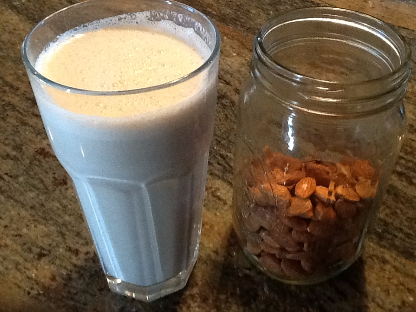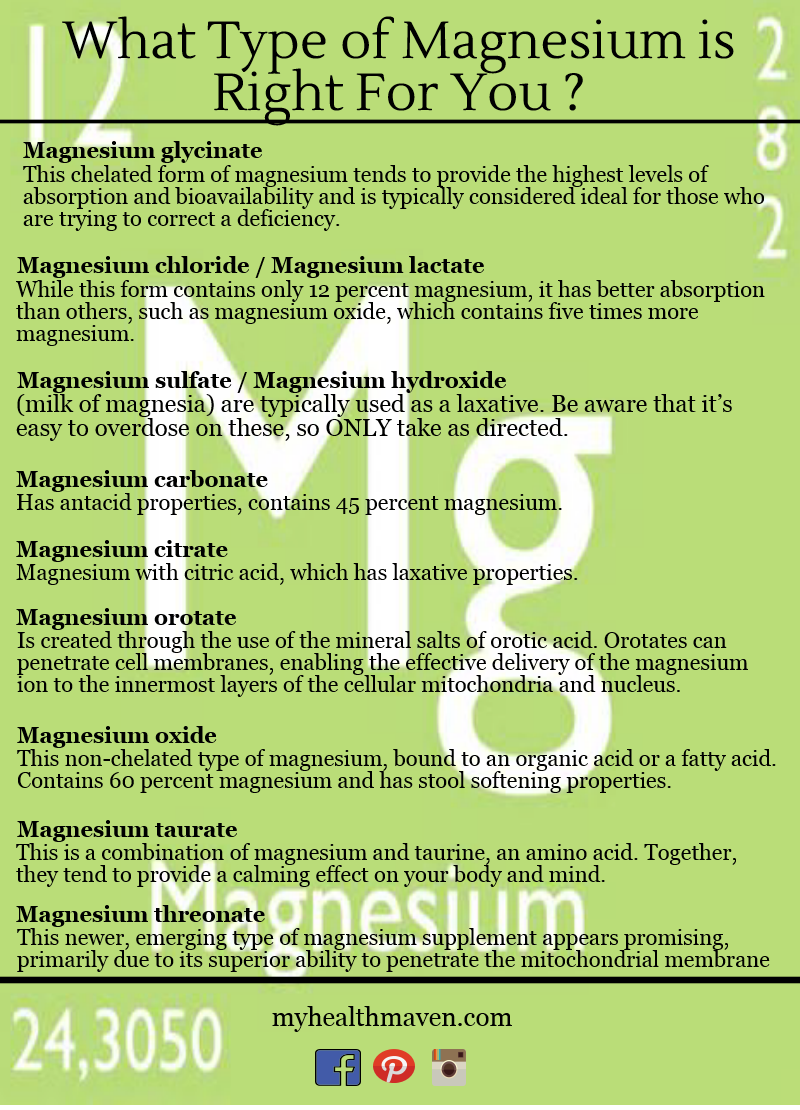Nondairy milk is all the rage, which isn’t so surprising since 75% of the world’s population is lactose intolerant. (a )Many people who are dairy intolerant are grateful to have so many options available to them. In this article we’ll be looking at cow milk and how it stacks up to almond milk, and how healthy it is or isn’t.
Dairy is somewhat of a controversial topic lately. There is a lot of debate about whether or not it is healthy. While the dairy industry would like you to believe cow products are good for strong bones, teeth and a great source of calcium, science has something else to say about it.
In fact, science is pointing to the fact that consuming dairy may actually be contributing to a number of health conditions and illnesses. (1)
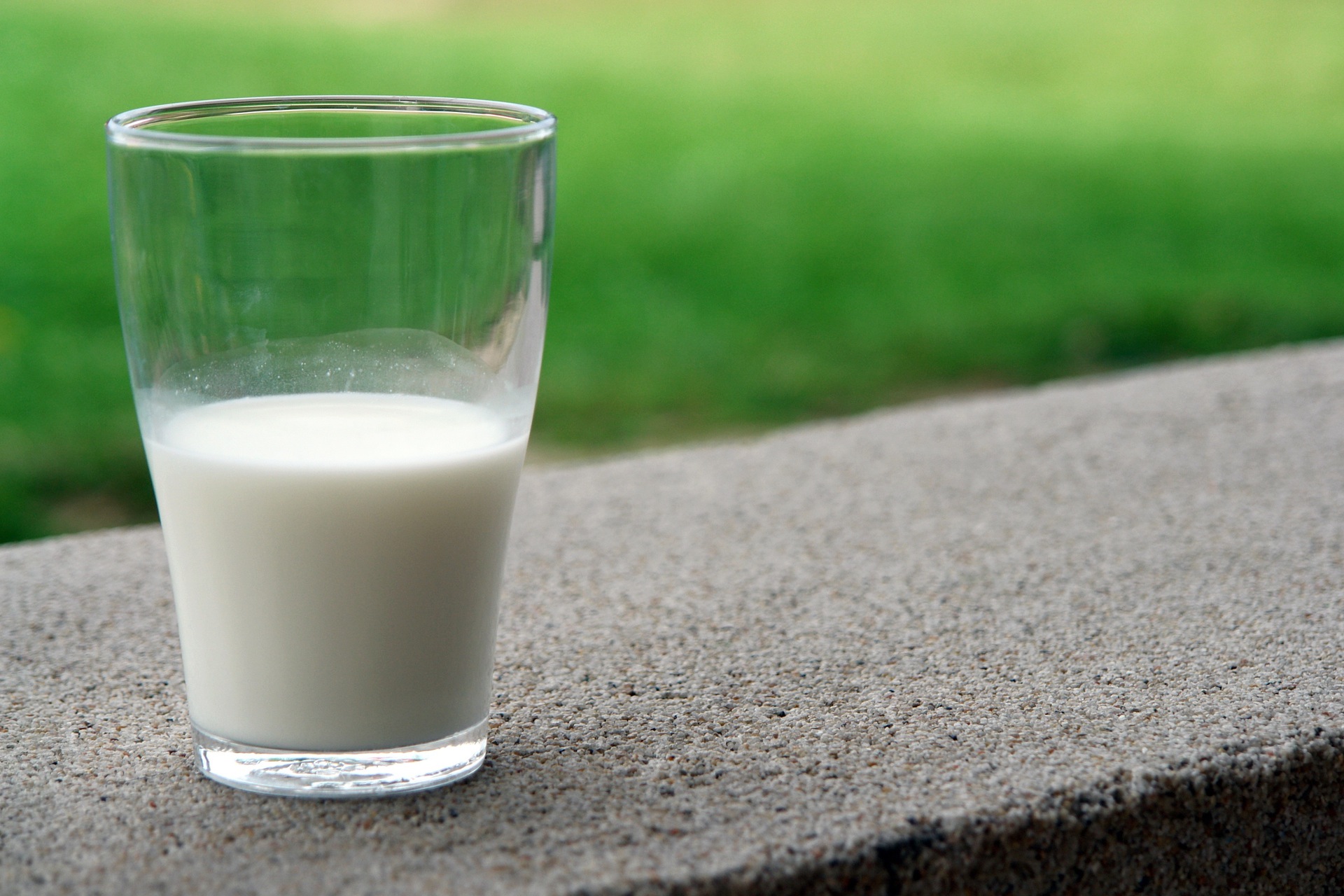
13 Reasons to avoid milk
According to Dr. Mark Hyman the majority of adults stop producing lactase sometime between the age of two and five. (2) Which may explain why many adults have a difficult time digesting dairy products. Lactase is an enzyme that the body needs to metabolize lactose. That in itself is the reason many people give up dairy, they simply don’t feel well when it’s consumed. Here are a few other reasons to reconsider dairy consumption.
Acne-Dairy consumption has minor link to increased acne. (3)
Allergen-Milk is the most self-reported food allergen. (4)
Bone fractures-Bone fractures are actually higher in countries that consume the most dairy and animal protein. (5) According to a study from BMJ, “Michaëlsson and colleagues suggest that milk is harmful because a metabolite of lactose, D-galactose, which mimics aging through inflammation and oxidative stress in animal models. (6)
Constipation-Children with constant constipation may simply have a milk allergy. (7)
Children’s illnesses-An allergy to cow’s milk in children “Should be considered in children with symptoms such as wheezing, rhinitis, dry cough, vomiting, laryngeal edema, acute asthma with severe respiratory distress, anaphylaxis. Late reactions due to cow’s milk allergy are atopic dermatitis, chronic diarrhea, blood in the stools, iron deficiency anemia, gastroesophageal reflux disease, constipation, chronic vomiting, colic, poor growth”. (8)
Diabetes-Cow’s milk protein may play a role in triggering type 1 diabetes through a process called molecular mimicry. (9)
Ear infections-Chronic ear infections are frequently linked to dairy allergies. (10)
Heiner’s syndrome-This respiratory disease in infants is primarily caused by consuming milk. (11)
Increased cholesterol-Milk fat contains a broad range of fatty acids and some have a negative impact on the cholesterol rich lipoproteins. While it is important to note that this is dependent of frequency and quantity of consumption. (12)
Inflammatory– D galactose in milk is inflammatory and increases sign of aging. Individuals with cow milk allergies also rate high on inflammatory scores. (13) Studies have connected full-fat dairy with disrupting our gut microbiome, actually decreasing levels of good gut bacteria which are key in reducing inflammation. (14)
Multiple Sclerosis-Countries that consume higher amounts of dairy, also have rates of MS. (15)
Nasal Polyps –An allergy to cow’s milk may be a contributing factor in chronic nasal polyps. (16)
Ovarian & prostate cancer risk-Evidence shows that consuming milk or dairy products may contribute to the risk of prostate and ovarian cancers. (17)
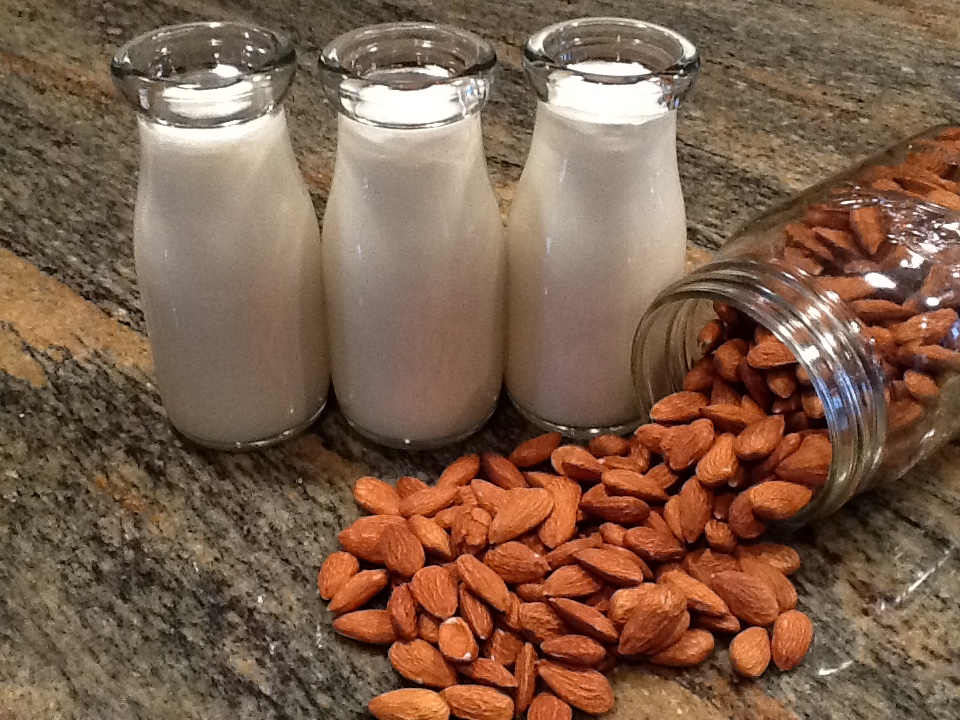
12 Benefits of almond milk
Almond milk is a wonderful option for anyone who is dairy or soy intolerant. This milk is low in fat, but high in iron, calcium, zinc, potassium, sodium, phosphorous and magnesium. Almond milk is also rich in vitamin C, B6, E thiamine, riboflavin, folate and niacin. (18) How various milks compare to each other varies greatly. It is dependent on the brand, additives and type of milk. Before buying nut milk be sure to compare similar varieties.
Aside from being a delicious food, almonds offer an extensive number of benefits. Studies have shown health benefits of nut consumption including reduced incidence of coronary heart disease, gallstones, hypertension, cancer, inflammation, blood pressure and metabolic syndrome. Here are just a few reasons to consider adding this healthy food to your diet. (19)
Cancer fighter-Gamma tocopherol (a type of vitamin E) is a potent antioxidant that can fight oxidative stress and free radical damage which are linked to cancer. Studies link higher vitamin E intake with lower rates of prostate and colon cancer. (19, 20, 21)
Constipation– Almonds are rich in fiber. Fiber is beneficial in helping to prevent constipation. (22)
Weight loss-Almonds contain monounsaturated fat which help to curb appetite and can prevent over eating. This study shows that people who consume almonds at least twice a week are more likely to remain at their ideal weight, rather than those who rarely or never consume almonds. (23)
Lowered Cholesterol– Almonds have been found to have a consistent LDL lowering effect in healthy individuals, and in individuals with high cholesterol and diabetes. (24)
Diabetes– Almonds are high in healthy fat, protein, fiber and magnesium. Magnesium is also needed for more than 300 bodily functions including controlling blood sugar levels. (25)
Blood pressure– Magnesium deficiency is linked to blood pressure problems. Almonds are high in magnesium and may be able to help reduce blood pressure issues. (26)
Heart Health-Some of the ingredients in almonds such as arginine, calcium, copper, manganese, magnesium, and potassium are important nutrients for heart health.
Nutrient Rich-Almonds are rich in fiber and protein. They also contain vitamin E, riboflavin, niacin, manganese, copper, calcium, iron and phosphorous. (27)
Brain health– Almonds contain L-carnitine and riboflavin two ingredients that positively affect brain activity and actually help prevent with cognitive decline.
Alzheimer’s– Several studies link lower rates of Alzheimer’s disease to high vitamin E consumption., as well as less cognitive decline with age. Thankfully almonds are high in vitamin E. (28, 29)
Immune system– Almonds contribute to the body’s alkalinity and have high levels of vitamin E, a powerful antioxidant that destroys free radicals in the body. Research also shows people whose intake of vitamin E is high are 30-40% less likely to suffer with heart disease. (30)
Gut Health– Almonds and almond skins are rich in fiber and other components that have potential prebiotic properties. This study showed significant increases in the populations of Bifidobacterium spp. and Lactobacillus spp. (31)
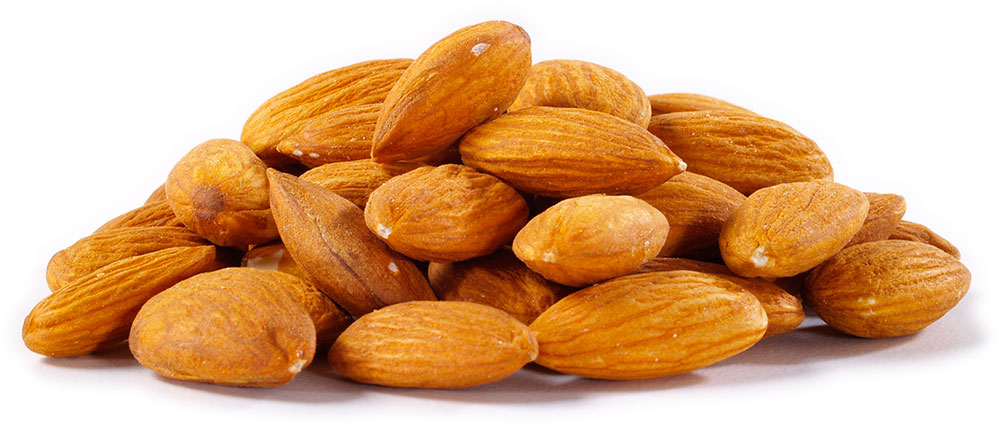
Nutrition of almonds
One cup of almonds (roughly equals 23 almonds) contains: (32)
- Fiber: 3.5 grams.
- Protein: 6 grams.
- Fat: 14 grams (9 of which are monounsaturated).
- Vitamin E: 37% of the RDA.
- Manganese: 32% of the RDA.
- Magnesium: 20% of the RDA.
- They also contain a decent amount of copper, vitamin B2 (riboflavin) and phosphorus.
Cow Milk vs. Almond Milk (B,C)
So which is nutritionally better cow milk or almond? They each have their benefits. Almond milk offers higher amounts of Vitamin E, D and A, as well as offering 20% of calcium daily values, compared to cow milk’s 28 %. Cow milk offers higher levels of protein, fat, carbs and calories. So it’s important to consider your nutritional needs, as well as the healthiest options for you.
While the calcium and protein levels are higher in cow’s milk there are certainly numerous food options for those who are dairy intolerant, or who wish to avoid any potential health risks.
|
Almond Milk |
Whole Milk | |
|
Calories |
40 | 146 |
|
Carbs |
2 grams | 12.8 grams |
| Protein | 1 gram |
7.9 grams |
| Fat | 3 grams |
7.9 grams |
|
Fiber |
1 gram |
0 |
|
Vitamin E |
10 milligrams (50 % DV) |
0.1 mg (1% DV) |
| Vitamin D | 100 IU vitamin D (25 % DV) |
97.6 IU (24% DV) |
|
Calcium |
200 milligrams (20 % DV) | 276 mg (28% DV) |
|
Vitamin A |
500 IU (10 % DV) | 249 IU (5% DV) |
| Magnesium | 16 milligrams (4 % DV) |
24.4 mg. (6% DV) |
| Phosphorous | 40 milligrams (4 % DV) |
222 mg. (22% DV) |
Buying or making almond milk?
Commercially made almond milk is available in many stores and online. It comes in a variety of flavors as well. Nutrient values and additives vary depending on the brand you purchase. If you do purchase store bought milk be sure to read the label and avoid unnecessary additives such as carrageenan, sugar. If possible it’s best to make your own milk at home, you’ll be assured of the freshness and ingredients.
Almond milk literally takes two minutes to make if you have a high speed blender. Here’s a recipe to get you started. Almond milk will keep up to five days in the refrigerator.
If you don’t enjoy almonds, there are numerous other options for dairy free milk including cashew, hemp, coconut, rice, macadamia, oat, pumpkin seed and soy to name a few.
Conclusion
There are many reasons people give up dairy, for some it is a conscious choice to not consume animal products, for others it is simply a health choice. Since there is much division about the whole topic, what is really comes down to for many is do you feel better with or without it?
References
A. (2011, August 15). What is Lactose Intolerance? Retrieved November 09, 2017, from http://www.pcrm.org/health/diets/vegdiets/what-is-lactose-intolerance
B. Almond Milk, Blue Diamond, Unsweetened Nutrition Facts. (n.d.). Retrieved November 14, 2017, from http://nutritiondata.self.com/facts/custom/278488/2
C. Milk, Whole 3.25% Milkfat Nutrition Data (n.d.) Retrieved November 14, 2017, from http://nutritiondata.self.com/facts/dairy-and-egg-products/69/2
1. Lanou, A. J. (2009, May). Should dairy be recommended as part of a healthy vegetarian diet? Counterpoint. Retrieved November 06, 2017, from https://www.ncbi.nlm.nih.gov/pubmed/19321571
2. Dairy: 6 Reasons You Should Avoid It at all Costs. (2017, January 03). Retrieved November 06, 2017, from http://drhyman.com/blog/2010/06/24/dairy-6-reasons-you-should-avoid-it-at-all-costs-2/
3. Kucharska, A., Szmurło, A., & Sińska, B. (2016, April). Significance of diet in treated and untreated acne vulgaris. Retrieved November 06, 2017, from https://www.ncbi.nlm.nih.gov/pmc/articles/PMC4884775
4. Rona, R. J., Keil, T., Summers, C., Gislason, D., Zuidmeer, L., Sodergren, E., . . . Madsen, C. (2007, September). The prevalence of food allergy: a meta-analysis. Retrieved November 06, 2017, from https://www.ncbi.nlm.nih.gov/pubmed/17628647
5. Lanou, A. J. (2009, May). Should dairy be recommended as part of a healthy vegetarian diet? Counterpoint. Retrieved November 06, 2017, from https://www.ncbi.nlm.nih.gov/pubmed/19321571
6. Michaëlsson, K., Wolk, A., Langenskiöld, S., Basu, S., Lemming, E. W., Melhus, H., & Byberg, L. (2014, October 28). Milk intake and risk of mortality and fractures in women and men: cohort studies. Retrieved November 06, 2017, from http://www.bmj.com/content/349/bmj.g6015
7. Dehghani, S. M., Ahmadpour, B., Haghighat, M., Kashef, S., Imanieh, M. H., & Soleimani, M. (2012, December). The Role of Cow’s Milk Allergy in Pediatric Chronic Constipation: A Randomized Clinical Trial. Retrieved November 06, 2017, from https://www.ncbi.nlm.nih.gov/pubmed/23429756
8. Caffarelli, C., Baldi, F., Bendandi, B., Calzone, L., Marani, M., Pasquinelli, P., & EWGPAG, O. B. (2010). Cow’s milk protein allergy in children: a practical guide. Retrieved November 06, 2017, from https://www.ncbi.nlm.nih.gov/pmc/articles/PMC2823764
9. Muntoni, S., Cocco, P., Aru, G., & Cucca, A. F. (2000, June 01). Sandro Muntoni. Retrieved November 06, 2017, from http://ajcn.nutrition.org/content/71/6/1525.full
10. Juntti, H., Tikkanen, S., Kokkonen, J., Alho, O. P., & Niinimäki, A. (n.d.). Cow’s milk allergy is associated with recurrent otitis media during childhood. Retrieved November 06, 2017, from https://www.ncbi.nlm.nih.gov/pubmed/10728925
11. Moissidis, I., Chaidaroon, D., Vichyanond, P., & Bahna, S. L. (2005, September). Milk-induced pulmonary disease in infants (Heiner syndrome). Retrieved November 06, 2017, from https://www.ncbi.nlm.nih.gov/pubmed/16176405
12. Ohlsson, L. (2010). Dairy products and plasma cholesterol levels. Retrieved November 06, 2017, from https://www.ncbi.nlm.nih.gov/pmc/articles/PMC2926059/
13. Bordoni, A., Danesi, F., Dardevet, D., Dupont, D., Fernandez, A. S., Gille, D., . . . Vergères, G. (2017, August 13). Dairy products and inflammation: A review of the clinical evidence. Retrieved November 06, 2017, from https://www.ncbi.nlm.nih.gov/pubmed/26287637
14. Conlon, M. A., & Bird, A. R. (2015, January). The Impact of Diet and Lifestyle on Gut Microbiota and Human Health. Retrieved November 06, 2017, from https://www.ncbi.nlm.nih.gov/pmc/articles/PMC4303825
15. Malosse, D., Perron, H., Sasco, A., & Seigneurin, J. M. (n.d.). Correlation between milk and dairy product consumption and multiple sclerosis prevalence: a worldwide study. Retrieved November 06, 2017, from https://www.ncbi.nlm.nih.gov/pubmed/1291895
16. Lill, C., Loader, B., Seemann, R., Zumtobel, M., Brunner, M., Heiduschka, G., & Thurnher, D. (n.d.). Milk allergy is frequent in patients with chronic sinusitis and nasal polyposis. Retrieved November 06, 2017, from https://www.ncbi.nlm.nih.gov/pubmed/22185729
17. Lanou, A. J. (2009, May). Should dairy be recommended as part of a healthy vegetarian diet? Counterpoint. Retrieved November 07, 2017, from https://www.ncbi.nlm.nih.gov/pubmed/19321571
18. Nuts, almonds [Includes USDA commodity food A256, A264] Nutrition Facts & Calories. (n.d.). Retrieved November 07, 2017, from http://nutritiondata.self.com/facts/nut-and-seed-products/3085/2
19. Ros, E. (2010, July). Health Benefits of Nut Consumption. Retrieved November 07, 2017, from https://www.ncbi.nlm.nih.gov/pmc/articles/PMC3257681/
20. Heinonen, O. P., Albanes, D., Virtamo, J., Taylor, P. R., Huttunen, J. K., Hartman, A. M., . . . Edwards, B. K. (1998, March 18). Prostate cancer and supplementation with alpha-tocopherol and beta-carotene: incidence and mortality in a controlled trial. Retrieved November 07, 2017, from https://www.ncbi.nlm.nih.gov/pubmed/9521168
21. Bostick, R. M., Potter, J. D., McKenzie, D. R., Sellers, T. A., Kushi, L. H., Steinmetz, K. A., & Folsom, A. R. (1993, September 15). Reduced risk of colon cancer with high intake of vitamin E: the Iowa Women’s Health Study. Retrieved November 07, 2017, from https://www.ncbi.nlm.nih.gov/pubmed/8364919
22. McFarland, E. (2016, August 20). What’s Your Daily Fiber Intake? Retrieved November 07, 2017, from http://myhealthmaven.com/whats-daily-fiber-intake/
23. Dhillon, J., Tan, S. Y., & Mattes, R. D. (2016, December). Almond Consumption during Energy Restriction Lowers Truncal Fat and Blood Pressure in Compliant Overweight or Obese Adults. Retrieved November 07, 2017, from https://www.ncbi.nlm.nih.gov/pubmed/27807041
24. Berryman, C. E., Preston, A. G., Karmally, W., Deckelbaum, R. J., & Kris-Etherton, P. M. (2011, April). Effects of almond consumption on the reduction of LDL-cholesterol: a discussion of potential mechanisms and future research directions. Retrieved November 07, 2017, from https://www.ncbi.nlm.nih.gov/pubmed/21457263
25. The Role of Magnesium in Clinical Biochemistry: An Overview. (n.d.). Retrieved November 07, 2017, from http://journals.sagepub.com/doi/abs/10.1177/000456329102800103
26. Houston, M. C., & Harper, K. J. (2008, July). Potassium, magnesium, and calcium: their role in both the cause and treatment of hypertension. Retrieved November 07, 2017, from https://www.ncbi.nlm.nih.gov/pubmed/18607145
27. (n.d.). Retrieved November 07, 2017, from https://ndb.nal.usda.gov/ndb/foods/show/3635?manu=&fgcd=
28. Sano, M., Ernesto, C., Thomas, R. G., Klauber, M. R., Schafer, K., Grundman, M., . . . Thal, L. J. (1997, April 24). A controlled trial of selegiline, alpha-tocopherol, or both as treatment for Alzheimer’s disease. The Alzheimer’s Disease Cooperative Study. Retrieved November 07, 2017, from https://www.ncbi.nlm.nih.gov/pubmed/9110909
29. Morris, M. C., Evans, D. A., Bienias, J. L., Tangney, C. C., & Wilson, R. S. (2002, July). Vitamin E and cognitive decline in older persons. Retrieved November 07, 2017, from https://www.ncbi.nlm.nih.gov/pubmed/12117360
30. Kris‐Etherton, P. M., Zhao, G., Binkoski, A. E., Coval, S. M., & Etherton, T. D. (2009, April 27). The Effects of Nuts on Coronary Heart Disease Risk. Retrieved November 07, 2017, from http://onlinelibrary.wiley.com/doi/10.1111/j.1753-4887.2001.tb06996.x/abstract
31. Liu, Z., Lin, X., Huang, G., Zhang, W., Rao, P., & Ni, L. (2014, April). Prebiotic effects of almonds and almond skins on intestinal microbiota in healthy adult humans. Retrieved November 07, 2017, from https://www.ncbi.nlm.nih.gov/pubmed/24315808
32. Nuts, almonds [Includes USDA commodity food A256, A264] Nutrition Facts & Calories. (n.d.). Retrieved November 07, 2017, from http://nutritiondata.self.com/facts/nut-and-seed-products/3085/2
This article was originally posted at The Hearty Soul.

